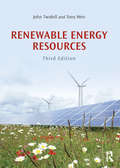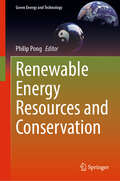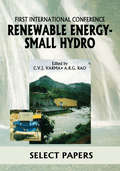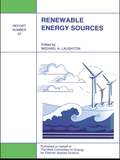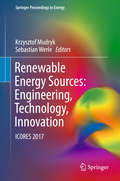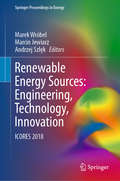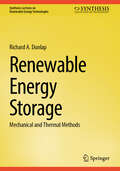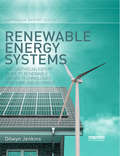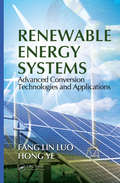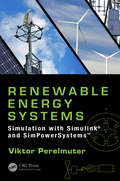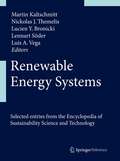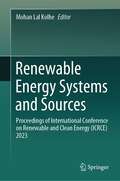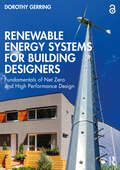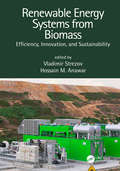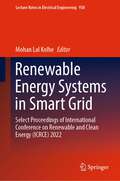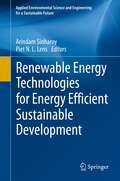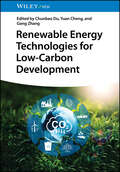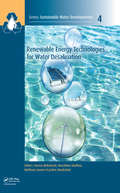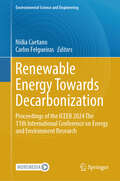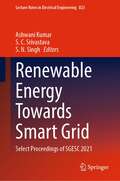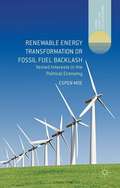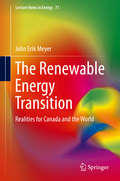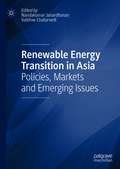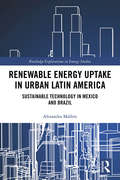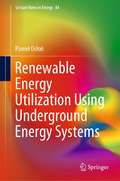- Table View
- List View
Renewable Energy Resources
by John Twidell Tony WeirRenewable Energy Resources is a numerate and quantitative text covering the full range of renewable energy technologies and their implementation worldwide. Energy supplies from renewables (such as from biofuels, solar heat, photovoltaics, wind, hydro, wave, tidal, geothermal, and ocean-thermal) are essential components of every nation’s energy strategy, not least because of concerns for the local and global environment, for energy security and for sustainability. Thus in the years between the first and this third edition, most renewable energy technologies have grown from fledgling impact to significant importance because they make good sense, good policy and good business. This Third Edition is extensively updated in light of these developments, while maintaining the book’s emphasis on fundamentals, complemented by analysis of applications. Renewable energy helps secure national resources, mitigates pollution and climate change, and provides cost effective services. These benefits are analysed and illustrated with case studies and worked examples. The book recognises the importance of cost effectiveness and efficiency of end-use. Each chapter begins with fundamental scientific theory, and then considers applications, environmental impact and socio-economic aspects before concluding with Quick Questions for self-revision and Set Problems. The book includes Reviews of basic theory underlying renewable energy technologies, such as electrical power, fluid dynamics, heat transfer and solid-state physics. Common symbols and cross-referencing apply throughout; essential data are tabulated in appendices. An associated eResource provides supplementary material on particular topics, plus a solutions guide to Set Problems. Renewable Energy Resources supports multi-disciplinary master degrees in science and engineering, and specialist modules in first degrees. Practising scientists and engineers who have not had a comprehensive training in renewable energy will find it a useful introductory text and a reference book.
Renewable Energy Resources and Conservation (Green Energy and Technology)
by Philip PongThis book offers a comprehensive overview of state-of-the-art research and development in diverse areas of renewable energy, including renewable energy storage, conservation, solar, wind, biomass, nuclear, geothermal, and renewable energy systems. It is a valuable resource for anyone interested in gaining insight into the latest advancements in renewable energy technologies and their applications. The book chapters present selected high-quality research from the 8th International Conference on Renewable Energy and Conservation (ICREC 2023) that analyze the latest trends and present case studies. Renewable Energy Resources and Conservation offers researchers, practitioners, professionals, and scientists working in renewable energy engineering a host of authoritative ideas and insights into renewable energy grid infrastructures, engineering design methods, technologies, and best practices to address industrial challenges.
Renewable Energy - Small Hydro
by C.V.J. Varma and A.R.G. RaoThis is a collection of conference papers on small hydro renewable energy, covering such topics as: resource assessment and planning; design and construction; and plant and equipment.
Renewable Energy Sources: Watt Committee: report number 22
by Michael A. LaughtonPresents and analyses the sources of renewable energy, including advantages and disadvantages, projects implemented internationally, cost and environmental implications, and the benefits of system integration.
Renewable Energy Sources: Icores 2017 (Springer Proceedings in Energy)
by Sebastian Werle Krzysztof MudrykThis volume presents refereed papers based on the oral and poster presentations at the 4th International Conference on Renewable Energy Sources, which was held from June 20 to 23, 2017 in Krynica, Poland. The scope of the conference included a wide range of topics in renewable energy technology, with a major focus on biomass and solar energy, but also extending to geothermal energy, heat pumps, fuel cells, wind energy, energy storage, and the modeling and optimization of renewable energy systems. The conference had the unique goal of gathering Polish and international researchers’ perspectives on renewable energy sources, and furthermore of balancing them against governmental policy considerations. Accordingly, the conference offered not only scientific sessions but also panels to discuss best practices and solutions with local entrepreneurs and federal government bodies. The Conference was jointly organized by the University of Agriculture in Krakow, the International Commission of Agricultural and Biosystems Engineering (CIGR), the Polish Society of Agricultural Engineering, AGH University of Science and Technology (Krakow), the Polish Society for Agrophysics under the patronage of the Rector of the University of Agriculture in Krakow, and the Polish Chamber of Ecology.
Renewable Energy Sources: ICORES 2018 (Springer Proceedings in Energy)
by Marek Wróbel Marcin Jewiarz Andrzej SzlękThis book presents peer-reviewed papers based on the oral and poster presentations during the 5th International Conference on Renewable Energy Sources, which was held from June 20 to 22, 2018 in Krynica, Poland. The scope of the conference included a wide range of topics in renewable energy technology, with a major focus on biomass, solar energy and geothermal energy, but also extending to heat pumps, fuel cells, wind energy, energy storage, and the modelling and optimization of renewable energy systems. This edition of the conference had a special focus on the role of renewable energy in the reduction of air pollution in the Eastern European region.Traditionally this conference is a unique occasion for gathering Polish and international researchers’ perspectives on renewable energy sources, and furthermore of balancing them against governmental policy considerations. Accordingly, the conference offered also panels to discuss best practices and solutions with local entrepreneurs and federal government bodies. The meeting attracts not only scientist but also industry representatives as well as local and federal government personnel. In 2018, the conference was organized by the University of Agriculture in Krakow in cooperation with AGH University of Science and Technology (Krakow), University of Žilina, Silesian University of Technology, International Commission of Agricultural and Biosystems Engineering (CIGR) and Polish Society of Agricultural Engineering. Honorary auspices were given by the Ministry of Science and Higher Education Republic of Poland, Rector of the University of Agriculture in Krakow and Rector of the AGH University of Science and Technology.
Renewable Energy Storage: Mechanical and Thermal Methods (Synthesis Lectures on Renewable Energy Technologies)
by Richard A. DunlapEnergy use is not uniform throughout the day and year. Renewable energy resources such as hydroelectric, wind, and solar energy, generate different amounts of energy over time and space, and are not always available when and where they are needed. A storage mechanism is often required to allow generated energy to be utilized effectively. This book reviews some of the important technologies for energy storage that utilize mechanical methods and thermal methods. In the first part of the book, mechanical energy storage methods are considered. These methods include pumped hydroelectric energy storage, gravitational potential of solid masses, and flywheels. In the second part, various methods of storing thermal energy are discussed. These include the use of the sensible heat of materials, the latent heat associated with phase transitions, and heat associated with chemical reactions.
Renewable Energy Systems: The Earthscan Expert Guide to Renewable Energy Technologies for Home and Business (Earthscan Expert)
by Dilwyn JenkinsThis book is the long awaited guide for anyone interested in renewables at home or work. It sweeps away scores of common misconceptions while clearly illustrating the best in renewable and energy efficiency technologies. A fully illustrated guide to renewable energy for the home and small business, the book provides an expert overview of precisely which sustainable energy technologies are appropriate for wide-spread domestic and small business application. The sections on different renewable energy options provide detailed descriptions of each technology along with case studies, installation diagrams and colour photographs, showing precisely what is possible for the average household. The chapter on how to select the renewable technology most appropriate for ordinary homes and businesses summarizes this analysis in a neat and easy to use table and demonstrates with examples exactly how to assess your local renewable resources. Renewable technologies covered include wood energy, wind power, solar photovoltaics, solar thermal, passive solar, geothermal and air-to-air heat pumps as well as water or hydro based energy systems – plus the all-important subject of energy efficiency. Whilst written to be accessible to a wide audience, the book is targeted at readers who are keen to work with renewable technologies, students, building engineers, architects, planners, householders and home-owners.
Renewable Energy Systems: Advanced Conversion Technologies and Applications (Industrial Electronics)
by Fang Lin Luo Ye HongEnergy conversion techniques are key in power electronics and even more so in renewable energy source systems, which require a large number of converters. Renewable Energy Systems: Advanced Conversion Technologies and Applications describes advanced conversion technologies and provides design examples of converters and inverters for renewable energy systems—including wind turbine and solar panel energy systems. Learn Cutting-Edge Techniques for Converters and Inverters Setting the scene, the book begins with a review of the basics of astronomy and Earth physics. It then systematically introduces more than 200 topologies of advanced converters originally developed by the authors, including 150 updated circuits on modern conversion technologies. It also discusses recently published topologies and thoroughly analyzes new converter circuits. Novel approaches include split-capacitor and split-inductor techniques that can be applied in super-lift and other converters. Resolve Historic Problems in Conversion Technologies Along with offering many cutting-edge techniques, the authors resolve some historic problems, such as the accurate determination of the conduction angle of single-phase rectifiers and power factor correction. They also describe a new series—laddered multilevel inverters—that uses few devices to produce more levels, overcoming the drawbacks of the pulse-width-modulation (PWM) inverter and providing great scope for industrial applications. Tap the Knowledge of Pioneers in the Field This book is written by pioneers in advanced conversion technology who have created a large number of converters, including the world-renowned DC/DC Luo-converters and super-lift Luo-converters. Featuring numerous examples and diagrams, it guides readers in designing advanced converters for use in renewable energy systems.
Renewable Energy Systems: Simulation with Simulink® and SimPowerSystems™
by Viktor PerelmuterThe development of renewable sources for electrical energy has become a mainstream focus in the field of electrical engineering. This book can be used by both engineers and researchers working to develop new electrical systems and investigate existing ones. Additionally, it can serve as a guide for undergraduate and graduate students during their study of electrical fields. The electrical devices that are used in renewable sources have complicated inner structures, and methods of computer simulation make the development of these systems easier and faster. Simulink, and its toolbox SimPowerSystems, is the most popular means for simulation of electrical systems. The topic of wind-generator (WG) systems simulation merits detailed consideration; therefore, this text covers an in-depth exploration of the simulation of WG systems, systems with batteries, photovoltaic systems, fuel elements, microturbines, and hydroelectric systems.
Renewable Energy Systems
by Lennart Söder Lucien Y. Bronicki Luis A. Vega Martin Kaltschmitt Nickolas J. ThemelisHumanity is facing a steadily diminishing supply of fossil fuels, causing researchers, policy makers, and the population as a whole to turn increasingly to alternative and especially renewable sources of energy to make up this deficit. Gathering over 80 peer-reviewed entries from the Encyclopedia of Sustainability Science and Technologies, Renewable Energy Systems provides an authoritative introduction to a wide variety of renewable energy sources. State-of-the-art coverage includes geothermal power stations, ocean energy, renewable energy from biomass, waste to energy, and wind power. This comprehensive, two-volume work provides an excellent introduction for those entering these fields, as well as new insights for advanced researchers, industry experts, and decision makers.
Renewable Energy Systems and Sources: Proceedings of International Conference on Renewable and Clean Energy (ICRCE) 2023
by Mohan Lal KolheThe book consists of selected and peer reviewed papers from 13th International Conference on Renewable and Clean Energy (2023), which aims to address and deliberate on the latest technical status and recent trends in the research and applications of renewable energy system and sources (RESSs), renewable energy sources include solar, wind, biomass, fuel cells, hydropower, hydrogen, nuclear, geothermal etc. The topics covered in the proceedings include energy transformation from renewable energy system (RES) to grid, novel energy conversion studies for RESs, power devices and driving circuits for RESs, control techniques for RESs, grid interactive systems used in hybrid RESs, performance analysis of RESs, hybrid RESSs, renewable energy research and applications for Industries, RESSs for electrical vehicles and components, artificial intelligence and machine learning studies for RESs and applications, computational methods for RESSs, smart grids and RESSs, safety and security of RESSs, renewable energy systems in smart cities. This book will be very useful for graduate students, researchers and practicing engineers working in the fields of renewable energy.
Renewable Energy Systems for Building Designers: Fundamentals of Net Zero and High Performance Design
by Dorothy GerringRenewable Energy Systems for Building Designers presents a comprehensive introduction to the latest resources and technologies used in high performance and net zero energy buildings, with a practical focus on the design and integration of these systems. This textbook and convenient reference offers a single-source guide to renewable technologies, balancing broad knowledge with the details of implementation crucial for successful sustainable design. It equips students and professionals with foundations and critical information needed to confidently plan for and meet the highest standards of energy efficiency in new construction and retrofitted buildings. Part I of the book establishes key principles of renewable systems, power production, and design for climate, introducing energy modeling and measurements of performance. Part II focuses in more depth on renewable energy systems, including photovoltaics, heat pumps, solar thermal, and more. Dedicated chapters break down the fundamental concepts behind each renewable technology and present guidelines for configuration and installation including system requirements, equipment specification, sizing, and location of components. Part III discusses topics relevant across renewable systems, including energy storage, control and monitoring, and cost/payback calculation. Part IV comprises case studies of exemplary renewable energy projects. Features: Covers resources and technologies including photovoltaics, solar thermal hot water, heat pumps, biomass, wind and microhydro turbines, marine renewable energy, deep cycle rechargeable batteries, and system controllers. Compiles up-to-date, essential information on designing with renewable systems in one location, organized by technology for easy reference. Presents clear explanations of all concepts and system aspects, using US/SI units and full-color diagrams and illustrations throughout. Features case studies of renewable energy systems in completed projects, demonstrating a range of climate specific applications. Includes study questions, a comprehensive guide to terminology and acronyms, spreadsheets for calculations, system sizing worksheets, and additional online resources. Renewable Energy Systems for Building Designers: Fundamentals of Net Zero and High Performance Design will serve as an essential introduction and enduring reference for students of architecture, engineering, construction, and building science. Equally valuable as a professional resource, it will quickly become the go-to guide for energy efficient design for practitioners in these areas.
Renewable Energy Systems from Biomass: Efficiency, Innovation and Sustainability
by Vladimir Strezov and Hossain M. AnawarNew innovations are needed for the invention of more efficient, affordable, sustainable and renewable energy systems, as well as for the mitigation of climate change and global environmental issues. In response to a fast-growing interest in the realm of renewable energy, Renewable Energy Systems: Efficiency, Innovation and Sustainability identifies a need to synthesize relevant and up-to-date information in a single volume. This book describes a systems approach to renewable energy, including technological, political, economic, social and environmental viewpoints, as well as policies and benefits. This unique and concise text, encompassing all aspects of the field in a single source, focuses on truly promising innovative and affordable renewable energy systems. Key Features: Focuses on innovations in renewable energy systems that are affordable and sustainable Collates the most relevant and up-to-date information on renewable energy systems, in a single and unique volume Discusses lifecycle assessment, cost and availability of systems Emphasizes bio-related topics Provides a systems approach to the renewable energy technologies and discusses technological, political, economic, social, and environmental viewpoints as well as policies
Renewable Energy Systems in Smart Grid: Select Proceedings of International Conference on Renewable and Clean Energy (ICRCE) 2022 (Lecture Notes in Electrical Engineering #938)
by Mohan Lal KolheThis book contains peer-reviewed papers from International Conference on Renewable and Clean Energy 2022 (contributions from various authors from all sectors of academia and industries), exploring cutting-edge solutions and best practices for renewable and clean energy technologies for achieving the UN's SDG7 to "ensure access to affordable, reliable, sustainable and modern energy for all." This book presents innovative grid integration technologies for techno-economic operation of renewable and clean energy technologies (e.g., solar photovoltaic, wind energy, hydrogen technologies including electrolyzer and fuel cell, energy storage technologies, etc.). It covers key aspects on energy conversion systems related to renewable energy technologies and their grid integration, techno-economic power dispatching from the distributed environmental-friendly energy sources considering combined heat and power applications, electrical energy network operation with increasing penetration of renewable energy sources, energy efficiency and demand side management, e-mobility, including machine learning applications for intelligent operation of energy systems, etc. The key objective of book is to educate the readers on how sustainable energy technologies can be integrated with energy conversion processes for achieving net zero targets in real-world applications. The book will serve as a useful reference for graduate students, academicians, industry professionals and policy makers interested in exploring the potential of energy technologies in development of sustainable energy system.
Renewable Energy Technologies for Energy Efficient Sustainable Development (Applied Environmental Science and Engineering for a Sustainable Future)
by Piet N. L. Lens Arindam SinharoyThe depletion of fossil fuel reserves and concerns for environmental degradation due to the fossil fuel burning have led the scientific community to look for alternative renewable energy sources. Among the available renewable energy sources, bioenergy derived from biomass and waste resources have great potential to not only prevent environmental pollution but also be a carbon neutral energy source. In addition, adaptation of this technology could streamline new green products, alternative energy sources into real-world applications and promote a circular economy towards zero-waste approach. This book tries to bridge the existing knowledge gap in the area of bioenergy resources. The first two chapters provide introduction to the anaerobic digestion (AD) technologies and direct interspecies electron transfer in AD. The next three chapters are on biomass pretreatment technologies for process improvement. The sixth to eighth chapter discuses biogas and other by-product production from specific wastes such from dairy, food and agricultural solid waste. The following two chapters focuses on the downstream processing of anaerobic digestate and on biochar production. Integration of AD in biorefineries using bioelectrochemical systems, syngas fermentation and electricity production are discussed in the next three chapters. The final two chapters elaborates on life cycle assessment of AD based technologies.
Renewable Energy Technologies for Low-Carbon Development
by Chunbao Du Yuan Cheng Gang ZhangSummary of cutting-edge research, latest advances, and future directions in low carbon and renewable energy systems Renewable Energy Technologies for Low-Carbon Development provides a comprehensive overview of recent and cutting-edge research progress in a variety of current renewable energy and low carbon development research areas, focusing on sustainable energy from various perspectives such as thermoelectric power generation, organic solar cells, Na-ion, solar thermochemical energy storage, and nano-friction power generation. The book discusses the methodologies and research development of each renewable energy route based on its unique characteristics. Following a brief overview of renewable energy, this book also reviews low-carbon research in traditional fossil energy and promotes the development of renewable energy with the sustainable recovery and utilization of carbon. Because of the uniqueness of CO2 in low-carbon development, CO2 storage and application are discussed separately. Written by three highly qualified authors, Renewable Energy Technologies for Low-Carbon Development explores sample topics including: Thermoelectric power generators and their applications, application of nanomaterials in organic solar cells, and advances in low-temperature Na-ion battery energy storage Thermochemical energy storage for renewable solar energy utilization, and recent progress and new challenges in triboelectric nanogenerators Manufacturing, recovery, and reuse of wind turbine blades in wind power generation and electrocatalysts for oxygen reduction in fuel cells Carbon fiber in renewable energy development, sustainable carbon nanofluids of petroleum extraction, and carbon dioxide capture and chemical conversion into fuels Renewable Energy Technologies for Low-Carbon Development is an essential reference on the subject for materials scientists, power engineers, electrochemists, electronics engineers, and all professionals working at energy supplying companies and in the broader chemical industry.
Renewable Energy Technologies for Water Desalination (Sustainable Water Developments - Resources, Management, Treatment, Efficiency and Reuse)
by Hacene Mahmoudi Noreddine Ghaffour Mattheus F.A. Goosen Jochen BundschuhThe book presents a thorough overview of the latest trends and challenges in renewable energy technologies applications for water desalination, with an emphasis on environmental concerns and sustainable development. Emphasis is on the various uses of renewable energy, as well as economics & scale-up, government subsidies & regulations, and environmental concerns. It provides an indication on how renewable energy technologies are rapidly emerging with the promise of economic and environmental viability for desalination. Further it gives a clear indication on how exactly to accelerate the expansion and commercialization of novel water production systems powered by renewable energies and in what manner environmental concerns may be minimized. This book is all-inclusive and wide-ranging and directed at decision makers in government, industry and the academic world as well as students.
Renewable Energy Towards Decarbonization: Proceedings of the ICEER 2024 The 11th International Conference on Energy and Environment Research (Environmental Science and Engineering)
by Carlos Felgueiras Nídia CaetanoThis book contains the full papers of the 11th edition of the International Conference on Energy and Environment Research, ICEER 2024, that took place in Coimbra, Portugal during July 24–26, 2024. ICEER 2024 is a joint organization of the School of Engineering (ISEP) of the Polytechnic of Porto (P.Porto) and the SCIEI. This book includes all the well prepared full papers presented at ICEER 2024.
Renewable Energy Towards Smart Grid: Select Proceedings of SGESC 2021 (Lecture Notes in Electrical Engineering #823)
by Ashwani Kumar S. N. Singh S. C. SrivastavaThe book contains select proceedings of the International Conference on Smart Grid Energy Systems and Control (SGESC 2021). The proceedings is divided into 03 volumes, and this volume focuses on renewable energy towards the smart grid. It includes papers related to smart grid, renewable energy, its integration, and DERs in the network for better energy management and ancillary services. The book presents cutting-edge research in the emerging fields of micro, nano, and smart devices and systems from experts. Most of the contributors have built devices or systems or developed processes or algorithms in these areas. This book is a unique collection of chapters from different areas with a common theme and will be immensely useful to academic researchers and practitioners in the industry.
Renewable Energy Transformation or Fossil Fuel Backlash: Vested Interests in the Political Economy (Energy, Climate and the Environment)
by Espen MoeRenewable Energy Transformation or Fossil Fuel Backlash.
The Renewable Energy Transition: Realities for Canada and the World (Lecture Notes in Energy #71)
by John Erik MeyerCanada is a well-endowed country that serves as an ideal model to lead the reader through the development of energy, resources, and society historically and into a post-carbon future. The book provides an historical perspective and describes the physical resource limitations, energy budgets, and climate realities that will determine the potential for any transition to renewable energy. Political and social realities, including jurisdiction and energy equality issues, are addressed. However, we cannot simply mandate or legislate policies according to social and political aspirations. Policies must comply with the realities of physical laws, such as the energy return on investment (EROI) for fossil-fuel based and renewable energy systems. EROI is discussed in both historical terms and in reference to the greater efficiencies inherent in a distributed generation, mainly electric, post-carbon society. Meyer explores the often misleading concepts and terms that have become embedded in society and tend to dictate our policy making, as well as the language, social and personal goals, and metrics that need to change before the physical transition can begin at the required scale. This book also reviews what nations have been doing thus far in terms of renewables, including the successes and failures in Canada and across the globe. Ontario’s green energy fiasco, and a comparison of the different circumstances of Norway and Alberta, for example, are covered as part of the author’s comparison of a wide range of countries. What are the achievements, plans, and problems that determine how well different countries are positioned to make “the transition”? The transition path is complex, and the tools we need to develop and the physical infrastructure investments we need to make, are daunting. At some point in time, Canada and Canadians, like all nations, will be living on 100% renewable energy. Whether the social and technological level that endures sees us travelling to the stars, or subsisting at a standard of living more similar to the pre-fossil fuel era, is far from certain.
Renewable Energy Transition in Asia: Policies, Markets and Emerging Issues
by Nandakumar Janardhanan Vaibhav ChaturvediThis book covers critical debates on policies, markets and emerging issues that shape renewable energy transition in the Asian region, which is fast becoming an epicenter of the global energy consumption. The chapters focus on domestic policies, geopolitics, technology landscape and governance structure pertaining to the development of renewable energy in different Asian countries ranging from China to the Middle East. The book presents an insightful view of the pace and magnitude of the energy transition. It presents critical steps countries are taking to promote affordable and clean energy (SDG 7) as well as strengthening climate mitigation actions (SDG 13). In addition, this book introduces the concept of co-innovation---a collaborative and iterative approach to jointly innovate, manufacture and scale up low-carbon technologies---and its role in promoting energy transition in Asia. Chapter 8 (Renewable energy deployment to stimulate energy transition in the Gulf Cooperation Council) is available open access under a Creative Commons Attribution 4.0 International License via link.springer.com.
Renewable Energy Uptake in Urban Latin America: Sustainable Technology in Mexico and Brazil (Routledge Explorations in Energy Studies)
by Alexandra MallettThis book explores the perplexing question of how to increase sustainable energy technology use in the developing world, and specifically focuses on two megacities within Latin America. Renewable Energy Uptake in Urban Latin America examines the market and uptake of two sustainable energy technologies (solar water heaters and biogas to produce electricity) in two locations, Mexico City, Mexico and São Paulo, Brazil in the 2000s. Drawing from three systems-based analytical frameworks – including one developed by the author for the purpose of this study – the book examines the varying factors affecting the implementation of renewable energy technologies (RETs) in urban Latin America. These frameworks emphasize the importance of examining socio-political dimensions; rather than conventional explanations that focus on technical and economic aspects only. By doing so, the research improves explanations about renewable energy technology (RET) adoption in the global South. These findings are useful for scholars, policy makers and practitioners working on RET adoption; resulting in a book which helps to inform wider debates regarding innovation, decarbonization, sustainability transitions and energy system change. This book will be of great interest to students and scholars of energy transitions, energy policy, development studies and science and technology studies.
Renewable Energy Utilization Using Underground Energy Systems (Lecture Notes in Energy #84)
by Paweł OcłońThis book discusses heat transfer in underground energy systems. It covers a wide range of important and practical topics including the modeling and optimization of underground power cable systems, modeling of thermal energy storage systems utilizing waste heat from PV panels cooling. Modeling of PV pannels with cooling. While the performance of energy systems which utilize heat transfer in the ground is not yet fully understood, this book attempts to make sense of them. It provides mathematical modeling fundaments, as well as experimental investigation for underground energy systems. The book shows detailed examples, with solution procedures. The solutions are based on the Finite Element Method and the Finite Volume Method. The book allows the reader to perform a detailed design of various underground energy systems, as well as enables them to study the economic aspects and energy efficiency of underground energy systems. Therefore, this text is of interest to researchers, students, and lecturers alike.
